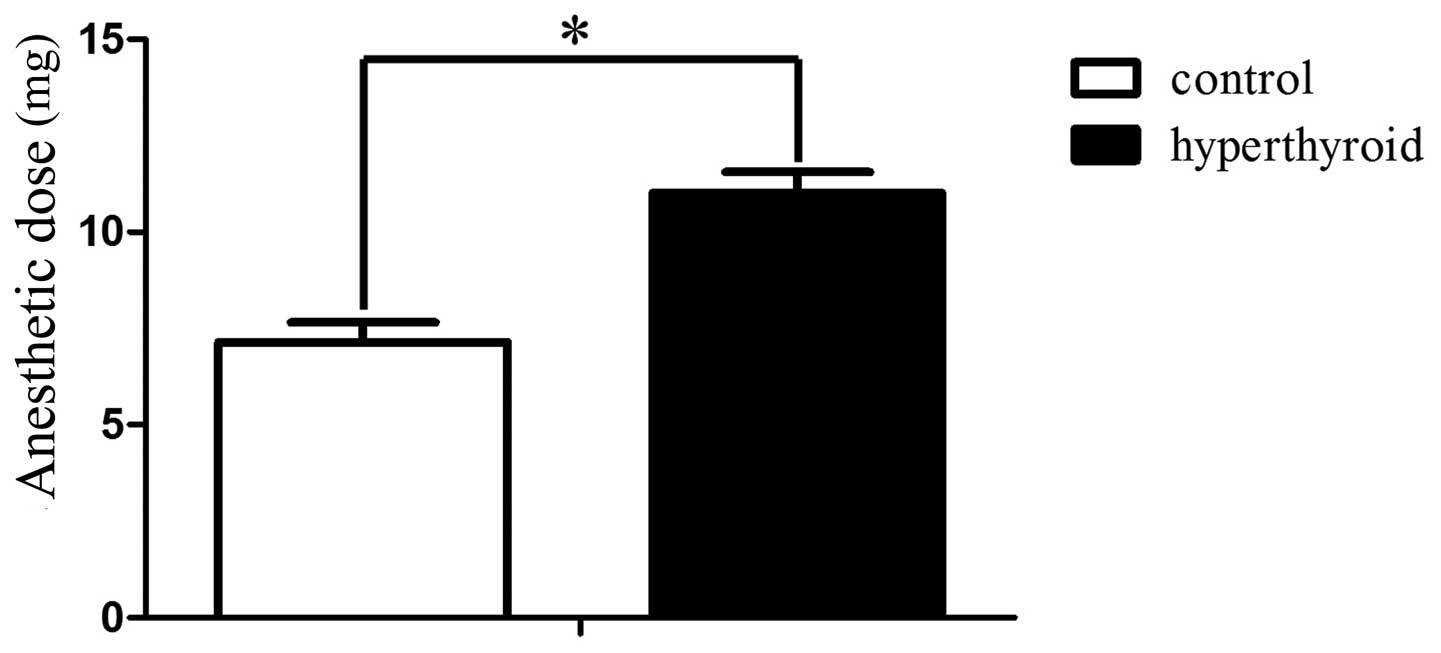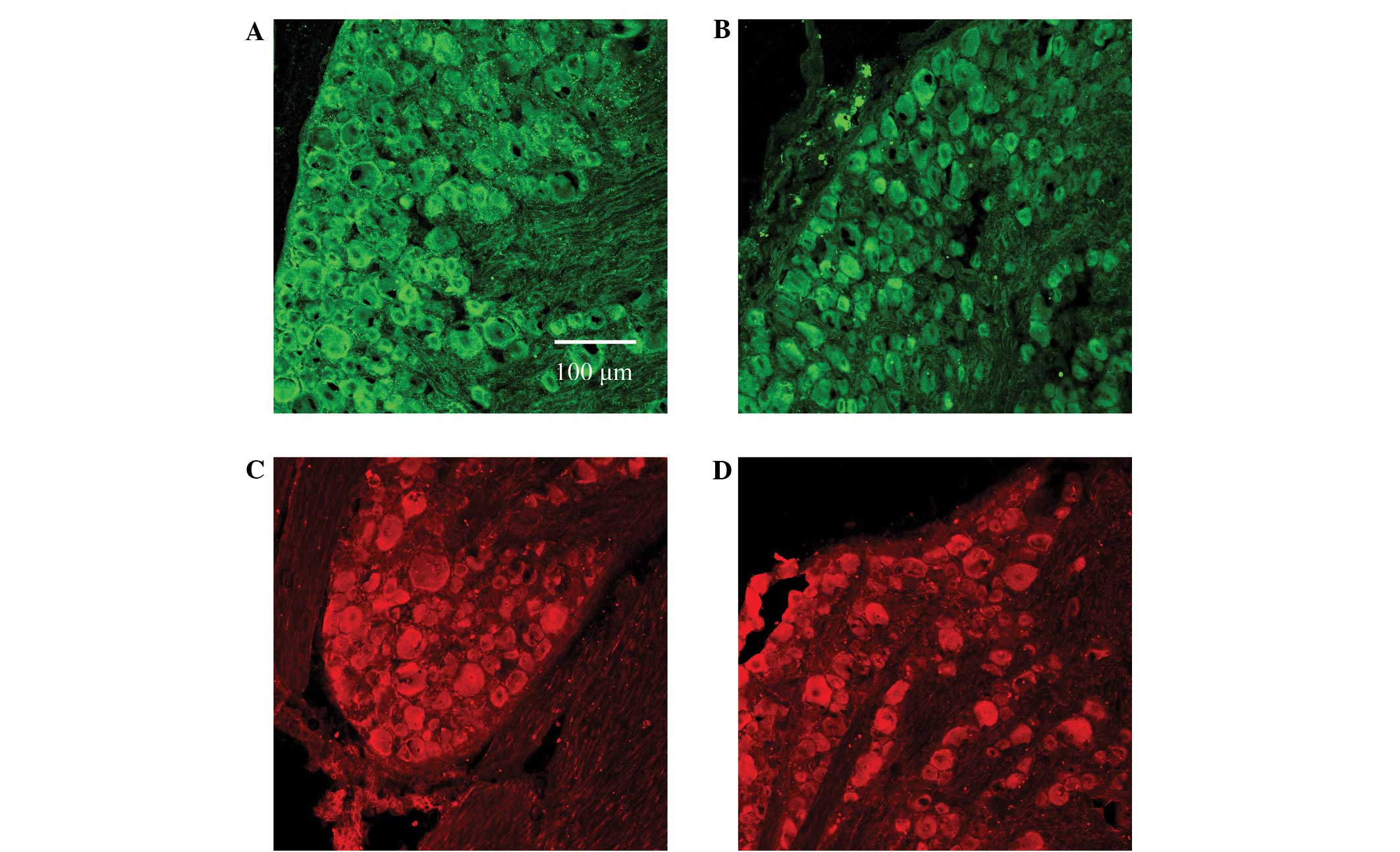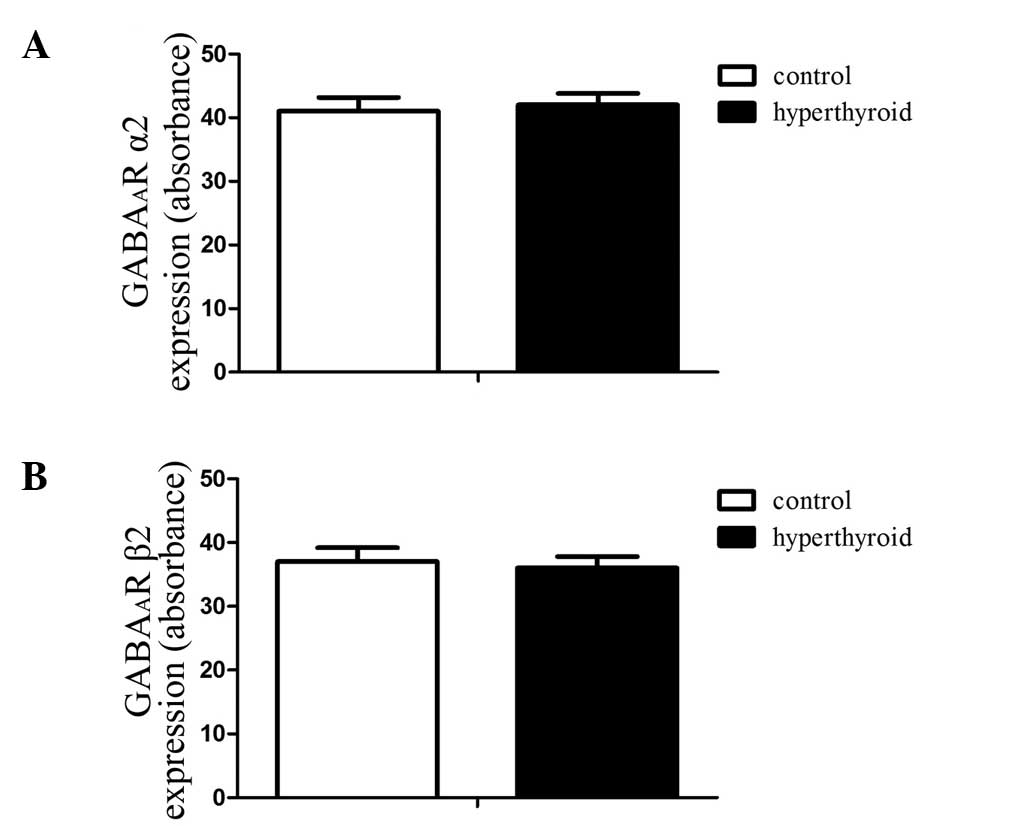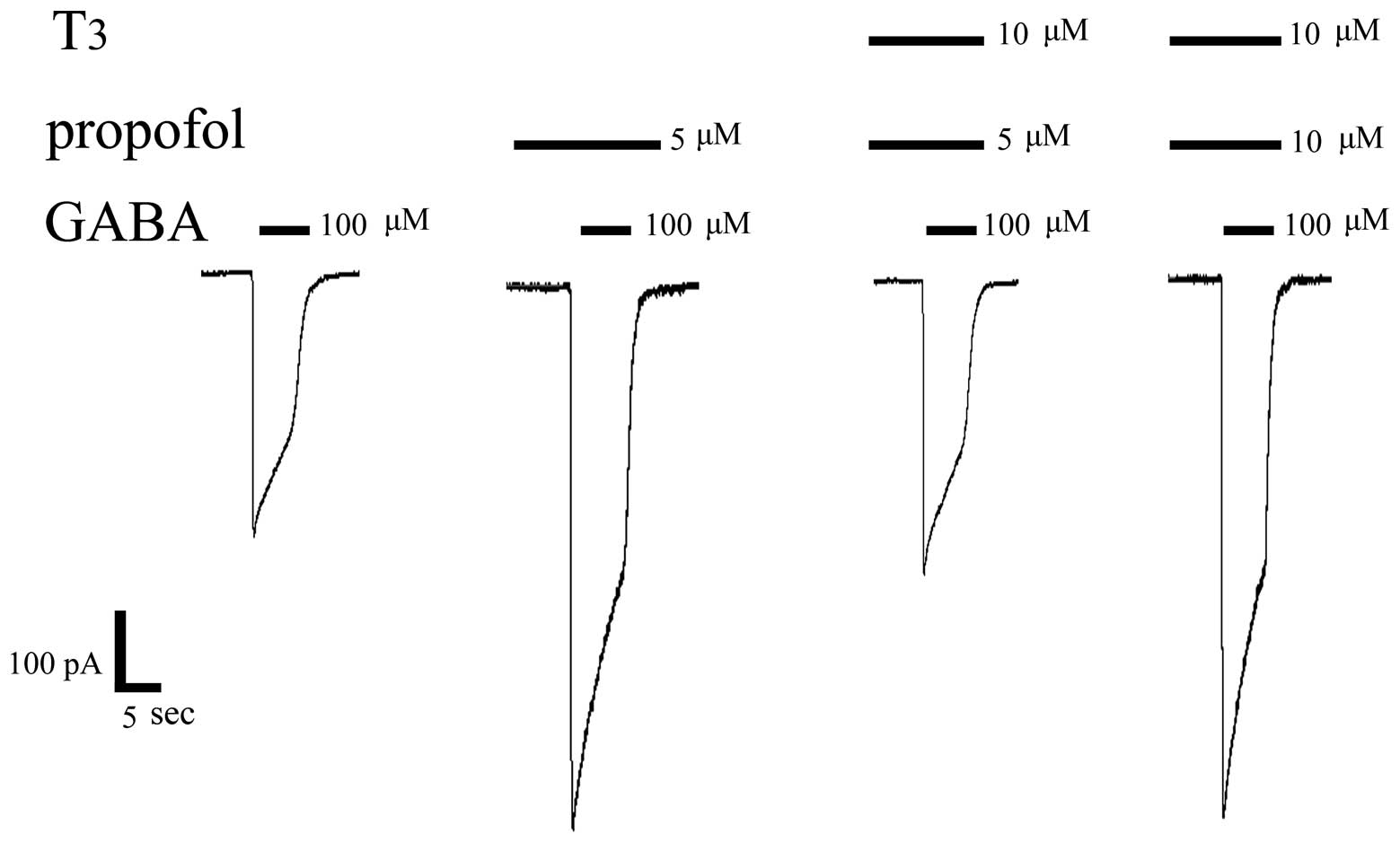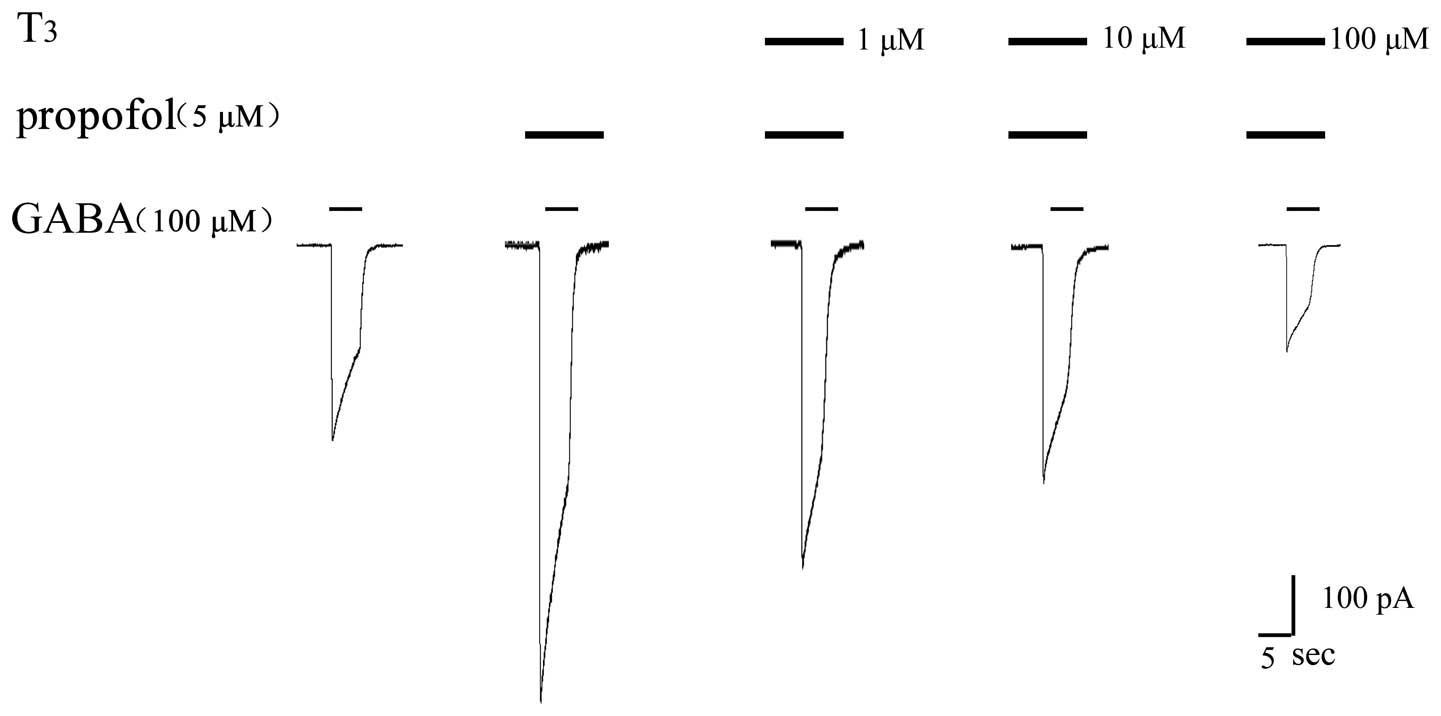Effect of non‑genomic actions of thyroid hormones on the anaesthetic effect of propofol
- Authors:
- Published online on: July 7, 2015 https://doi.org/10.3892/etm.2015.2624
- Pages: 959-965
-
Copyright: © Wang et al. This is an open access article distributed under the terms of Creative Commons Attribution License.
Abstract
Introduction
Propofol is the most widely used intravenous general anaesthetic worldwide. Hyperthyroidism is a common endocrine system disease (1–3). In clinical terms, additional propofol anaesthesia is required during surgery for patients with hyperthyroidism compared with those with normal thyroid function (4–7). Propofol is a primary intravenous general anaesthetic that is accepted and used worldwide due to its ability to enhance γ-aminobutyric acid (GABA)-mediated inhibition in the nervous system (8,9). GABA is a natural inhibitory neurotransmitter, and the GABA receptor (GABAR) comprises GABAAR, GABABR and GABACR subclasses. Considering that GABAAR is a ligand-gated ion channel receptor, GABA can inhibit presynaptic neurotransmitter release and generate analgesia through a primary afferent depolarisation process by acting on GABAAR localised on primary afferent neurons (10,11). Approximately 19 known subunits (α1–6, β1–3, γ1–3, δ, ε, θ, π and ρ1–3) constitute the GABAAR (10,12), and all these subunits share an integral channel, which is permeable to Cl− ions. Dorsal root ganglions (DRGs) are nociceptive primary afferent sensory neurons, and the GABA neurotransmitter/receptor system has an important role in the modulation of spinal nociceptive information.
As basal hormones, thyroid hormones (THs) have an essential role in maintaining the functional activity of the body and in heat production, metabolism, tissue differentiation and organ growth. The majority of the biological effects of TH are mediated by nuclear TH receptors (TRs). Two kinds of receptor, namely TRα and TRβ, have been found (13). Similar to other nuclear transcription factor families, TR can combine with other nuclear transcription factors to mediate the target gene expression. In a previous study it was found that the biological effects of THs are rapid and unaffected by inhibitors associated with genetic transcription. This fact demonstrates the importance of the non-genetic effects of THs, which can affect the functions of the GABAA receptors (14).
Materials and methods
Animals and experimental procedures
With the permission and using the protocol of the Committee of Animal Use for Research and Education of Wuhan University (Wuhan, China), male Sprague-Dawley rats (weighing 200–250 g) were purchased from the Center for Animal Experiments, Wuhan University and housed under a temperature- and light-controlled environment (22±1 h on a 12-h light/dark cycle at 60% humidity). Standard rat chow diet and water were given ad libitum. Rats were randomly divided into two groups: Control (n=30) and hyperthyroid (n=30). Over 14 days, hyperthyroidism was induced in the rats of the hyperthyroid group with daily injections of 3,3′,5-L-triiodothyronine (T3) [7 µg/100 g body weight (BW) in 0.01 mM NaOH, intraperitoneally], whilst only a daily injection of the vehicle was given to the control rats. Approximately 24 h following the last dose of T3, the rats were sacrificed by decapitation without other special treatment. To evaluate the TH serum levels and confirm the hyperthyroid status of the animals, blood samples were carefully collected. Sixty rats were used in the final experiment: 20 and 10 rats from each group were utilised for the electrophysiology and immunofluorescence experiments, respectively. Propofol was dissolved in soybean oil at a concentration of 10 mg/ml. The rats in the two groups were tested to determine the propofol dosage required for successful anesthesia after 14 days of treatment. The success of the anaesthesia was monitored by righting reflex and the propofol dosage was calculated by measuring the volume of soybean oil that was administered. Chemicals were purchased from Sigma-Aldrich (St. Louis, MO, USA) and stored according to the manufacturer's instructions unless otherwise specified.
Enzyme-linked immunosorbent assay of T3 and T4 concentrations
An enzyme-linked competitive immunosorbent assay with biotin-avidin amplification was employed (Beijing North Institute of Biological Technology Co., Ltd., Beijing, China). Serum T3 levels were determined by a competitive binding assay in which T3 in the sample and biotin-labeled T3 competitively bound with anti-T3 antibodies on 96-well-microtiter plates. Once reaction equilibrium was reached after 45 min at 37°C, horseradish peroxidase-labeled avidin was added and complexes were formed. Following the addition of substrate for colour development, optical density values were determined at 450 nm using a Bio-Rad 680 microplate reader (Bio-Rad Laboratories, Inc., Hercules, CA, USA). Their values are inversely proportional to the concentration of T3 in the sample. The levels of T4 were evaluated by a similar assay.
Electrophysiological recordings of DRG neurons
The DRG neurons were pulled out from the spines of the rats, immersed in extracellular fluid, cut into pieces and then soaked in the extracellular fluid with collagenase and trypsin at 37°C for 15 min and then centrifuged at 111.8 g for 5 min. The supernatant was then removed and the neurons were stood for 30 min to reach adherence. With the aid of a whole-cell patch clamp amplifier, perforated patch-clamp recordings in the whole-cell mode were performed. Using an Axon 700B amplifier (Axon, San Jose, CA, USA) and pCLAMP 0.2 hardware and software (Axon), currents were recorded from the DRG neurons in vitro. The room temperature was set at 22–24°C. The internal solution was added to micropipettes containing 150 mM KCl and 10 mM 4-(2-hydroxyethyl)-1-piperazineethanesulfonic acid (HEPES). Osmolarity was regulated at 320 mOsm/l with glucose. The pH was maintained at 7.2 with KOH. On the day of the experiment, amphotericin B was prepared as a stock solution by dissolving in dimethyl sulphoxide. The recording electrodes were backfilled with amphotericin B-containing solution, and the tip of the electrode was filled with amphotericin B-free solution. The experiment required 15–30 min to obtain a stable series resistance and 5–10 min to perforate the membrane. Cells were immersed in an external solution containing 2.5 mM CaCl2, 2 mM MgCl2, 10 mM HEPES, 10 mM D-glucose, 150 mM NaCl and 5 mM KCl. The pH was maintained at 7.4 with NaOH, and the osmolarity of the solution was maintained at 330 mOsm/l with glucose. The resistance of the recording pipette ranged from 3 to 5 MΩ. The membrane currents were recorded following adjustment of the capacitance and series resistance compensations. Without other specific indication, the holding potential was adjusted to −60 mV and the membrane currents were filtered at 10 kHz. GABA, GABA + T3, GABA + propofol and GABA + propofol + T3 were successively injected in the same cell at various concentrations to detect the effect of T3 and propofol on DRG neurons.
Immunofluorescence
Following anaesthetization with sodium pentobarbital (60 mg/kg), the rats in the control and hyperthyroid groups were subjected to cardiac perfusion with physiological saline followed by 4% paraformaldehyde in 0.1 M phosphate buffer (pH 7.4). Lumbar1–5 DRGs were bilaterally removed. For 4 h, DRGs were kept in a fixative state at 4°C, and then separately soaked in 10, 20 and 30% sucrose at 4°C until the DRGs settled at the bottom. The DRGs were then embedded in an optimal cutting temperature compound (OCT; Sakura Finetek USA, Inc., Torrance, CA, USA) and segmented using a cryostat at 10-µm thickness. The sections were kept at −80°C prior to use. The sections were pretreated with acetone (at 4°C), 0.3% Triton X-100 and 5% normal foetal calf serum prior to incubating overnight at 4°C in a humid chamber with goat polyclonal primary antibodies against GABAAα2 (sc-7350; 1:50; Santa Cruz Biotechnology, Dallas, TX, USA) and GABAAβ2 (sc-7362; 1:50; Santa Cruz Biotechnology). The sections were incubated respectively with donkey anti-goat immunoglobulin (Ig)G conjugated with tetramethylrhodamine isothioscyanate (1:100; Santa Cruz Biotechnology) or donkey anti-goat IgG conjugated with fluorescein isothiocyanate (1:100; Santa Cruz Biotechnology) at 37°C for 1 h following a thorough rinsing with phosphate-buffered saline (PBS). The antibodies were diluted in 0.01 M PBS. The primary antibodies were excluded from the control experiments, leading to the negative staining of all examined sections. Sections were examined under a laser confocal microscope (LSM 710; Carl Zeiss Microscope, Jena, Germany). Analytical software was used to quantitatively analyse the immunofluorescence (hp9001; Carl Zeiss Microscope).
Statistical analysis
Data are presented as mean ± standard error of the mean and were analysed and using SPSS software (version 17.0; SPSS, Inc., Chicago, IL, USA). In cases of homogeneity of variance, the least significant difference t-test, one-way analysis of variance and two-group comparison were performed. P<0.05 was considered to indicate a statistically significant difference.
Results
Validation of hyperthyroidism in experimental rat models
The serum levels of free T3 and T4 were measured to confirm whether hyperthyroidism was successfully induced in the T3-treated rats. The increased T3 and decreased T4 serum levels observed in the T3-treated rats are in accordance with hyperthyroidism (Table I).
Anaesthetic dose of control and hyperthyroid groups
The anaesthetic dose for the control and hyperthyroid groups was 7.14±0.51 and 11.02±0.53 mg/100 g BW (P<0.05), respectively (Fig. 1). The intraperitoneal injections of propofol anaesthesia to the rats in the control and hyperthyroid groups were successful since the righting reflex was absent.
Subunit expression differences of GABAA receptors α2 and β2
Immunofluorescence staining was used to indicate the expression of DRG GABAA receptor α2 and β2 subunits in rats in the control and hyperthyroid groups, and any differences in their expression levels were determined using quantitative analysis.
The results showed no statistical difference in the expression of either GABAA receptor subunit α2, marked by green immunofluorescence, or in GABAA receptor subunit β2, marked by red immunofluorescence (Figs. 2 and 3). The absorbance values of the DRG GABAA receptor subunits α2 and β2 of the control group were 40.5±2.05 and 38.2±1.95, respectively, whilst those of the hyperthyroid group were 41.1±2.17 and 37.8±1.84, respectively.
Comparison of GABA-activated currents
GABA induced a concentration-dependent (0.01–1,000 µM) inward current in the DRG neurons of rats in the control and hyperthyroid groups (Fig. 4).
THs inhibit GABA-evoked currents in DRGs
Using the patch clamp technique in the whole-cell configuration, the effect of T3 on the GABA-induced currents recorded in DRG was tested. T3 reduced the currents in a dose-dependent manner (Fig. 5). The concentration response curves showed an approximate IC50 of 10±3 µM for T3. No direct T3 channel gating was observed at any of the concentrations investigated.
T3 inhibits the augmentation effect of propofol on the GABA-activated currents
Since T3 inhibits GABA-activated currents in DRG, in order to determine if T3 inhibits or minimises the augmentation effect of propofol on the GABA-activated currents, GABA, GABA + propofol and GABA + propofol + T3 were successively injected in the same cell (Figs. 6 and 7). The following procedures were performed in the same-cell experiments: i) 100 µM GABA, which can induce an inward current, was injected. The activated current for the GABAAR was 450±35 pA; ii) 5 µM propofol was pre-perfused followed by 100 µM GABA, which induced an increase of the inward current, demonstrating that propofol has an inductive effect on GABA-activated currents and that this is the anaesthetic mechanism. The activated current for GABAAR was 860±41 pA; iii) a mixture of 10 µM T3 and 5 µM propofol was pre-perfused, followed by 100 µM GABA, which then clearly showed that the augmentation effect of propofol on the GABA-activated currents was significantly reduced by T3. The activated current for the GABAAR was 470±43 pA; iv) the propofol concentration was increased, and detection of the 100 µM GABA-activated currents following the pre-perfusion of the mixture of 10 µM T3 and 10 µM propofol demonstrated that the inward current increased. This result indicated that an increased propofol concentration can partially offset the inhibitory effect of T3 on GABA-activated currents. The activated current for the GABAAR was 856±39 pA. The results presented in Fig. 7 show that a statistically significant difference exists in the GABA-induced current amplitude between GABA + propofol (5 µM) and GABA + propofol (5 µM) + T3 (10 µM; P<0.05). A statistically significant difference also exists between GABA + propofol (5 µM) + T3 (10 µM) and GABA + propofol (10 µM) + T3 (10 µM; P< 0.05).
Further experiments were carried out to investigate whether a higher concentration of T3 produced a stronger inhibitory effect on the anaesthetic effect of propofol. GABA, GABA + propofol and GABA + propofol + T3 at various concentrations were successively injected into the same cell to validate the effect of T3. The results are shown in Figs. 8 and 9, and demonstrate that a higher concentration of T3 produced a stronger inhibitory effect on the propofol-augmented increase in GABA-induced current.
Perfusion of 100 µM GABA produced an activated current for the GABAAR of 450±35 pA. When pre-perfusion was conducted with 5 µM propofol, the activated current for GABAAR was 860±41 pA. The activated current for the GABAAR was 628±46 pA following the perfusion of 1 µM T3 and 5 µM propofol, and was 470±43 pA following the pre-perfusion of 10 µM T3 and 5 µM propofol. Finally, the activated current for GABAAR was 326±38 pA following the pre-perfusion of 100 µM T3 and 5 µM propofol.
The bar chart in Fig. 9 shows that a statistically significant difference exists between GABA + propofol (5 µM) and GABA + propofol (5 µM) + T3 (1 µM; P<0.05), and between GABA + propofol (5 µM) and GABA + propofol (5 µM)+T3 (10 µM; P<0.05). In addition, a statistically significant difference exists between GABA + propofol (5 µM) and GABA + propofol (5 µM) + T3 (100 µM; P<0.05).
Discussion
THs, as basal hormones, have important roles in energy utilisation, tissue differentiation, metabolism and organ growth, as well as in maintaining the functional activities of the body (15). THs are mainly involved in the development and functioning of the central nervous system (16–18). The direct transcriptional effects of TH bound to nuclear TRs mediate the majority of the TH effects. A new mechanism of TH action had been previously identified, and is a novel development of the traditional view that THs mediate their effects by controlling gene expression by binding to nuclear receptors TRα and TRβ. According to the study (19), this novel mechanism of TH action is rapid and unaffected by RNA and protein synthesis inhibitors. These facts are indicative of a non-classical nuclear TR-mediated action (19,20). Furthermore, the non-classical nuclear TR-mediated action of TH has been verified in human fibroblasts, human glioma, cardiomyocytes and osteoblasts. The GABAergic system is also an important target for the non-genomic action of THs (20–26).
Propofol is the most widely used short-acting intravenous general anaesthetic. In the classical view, the antalgic mechanism of propofol is mainly associated with an increase in the function of the GABAA receptors and the inhibitory post-synaptic potential. In clinical terms, additional propofol general anaesthesia is required during surgery for patients with hyperthyroidism compared with those with normal thyroid function. A representation of the result was provided in the present study using a hyperthyroidism model.
Rats with hyperthyroidism require propofol administration at 11.02 mg/100 g BW and control rats at 7.14 mg/100 g BW. To determine why the two groups require different doses of propofol anaesthetic, a DRG immunofluorescent assay was performed. This assay was conducted to evaluate if any changes in the distribution and number of the GABAA receptors in the DRG neuron occur and to determine if THs alter the functions of the GABAA receptors by changing their distribution and number. The results showed that the expression levels of GABAA receptor subunits α2 and β2 did not differ between the control and hyperthyroid groups (Figs. 2 and 3). Considering that the subunits α2/β2/γ2 constitute the GABAA receptor, it may be assumed that the hyperthyroid model does not change the distribution and number of the GABAA receptors. The changes in the GABA-activated currents in the DRG neurons of the hyperthyroid and control rats were then investigated. Whole-cell patch clamp recording tests were performed on an acutely isolated DRG neuron; however, no statistical difference was found between the two groups at various doses. The results indicated that there was no significant difference between the GABA-activated currents in the TH-free interstitial fluids of the hyperthyroid and control rats (Fig. 4). The non-genomic effects of THs on the GABAA receptors were considered, and the inhibitory effect of T3 on the GABA-activated currents in DRG neurons was examined (Fig. 5). T3 inhibits the current-augmenting and anaesthetic effect of propofol on GABAA receptors (Fig. 6). Propofol can increase the amplitude of GABA-activated currents. The current amplitude decreased when propofol was simultaneously pre-perfused with T3 at various concentrations, and a higher concentration of T3 induced stronger inhibition; therefore, it appears that the non-genomic effects of THs were achieved by inhibiting the activities of the GABAA receptors to mitigate the anaesthetic effect of propofol. With increasing concentrations of THs, the inhibitory effects strengthened. Fig. 7 shows that 5 µM propofol enhanced the GABA-activated currents; however, with 10 µM T3, the effect of propofol on the GABA-activated currents was inhibited. A higher concentration of propofol was shown to offset the inhibitory effect of T3 through the simultaneous use of 10 µM propofol and T3 with the same concentration.
The ideal situation is to have effective anaesthesia with less anaesthetic, but additional propofol anaesthesia during surgery is necessary for patients with hyperthyroidism compared with those with a normal thyroid function. Additional anaesthetic suggests greater anaesthesia risks and adverse reactions; therefore, according to the current study, higher levels of THs in patients with hyperthyroidism inhibit the augmentation effect of propofol on GABAA receptors. This inhibitory effect leads to less propofol-induced anaesthesia. Given that the mechanism through which T3 inhibits the GABAA receptors is unclear, the optimum method of anaesthesia for patients with hyperthyroidism is the control of hyperthyroidism prior to surgery in order to reduce TH levels. It is expected that the mechanism through which T3 inhibits the GABAA receptors will be determined in future research. By preventing this inhibition using a specific blocking agent, the optimum anaesthesia effect of propofol can be achieved.
Acknowledgements
The authors would like to express their thanks to all those who helped in the writing of this paper.
Glossary
Abbreviations
Abbreviations:
|
GABA |
γ-aminobutyric acid |
|
GABAAR |
γ-aminobutyric acid type A receptor |
|
T3 |
3,3′,5-L-triiodothyronine |
|
T4 |
thyroxine |
|
DRG |
dorsal root ganglion |
References
|
Greenhill C: Thyroid function: Hyperthyroidism - psychiatric issues. Nat Rev Endocrinol. 10:652014. View Article : Google Scholar | |
|
Brandt F, Thvilum M, Almind D, et al: Hyperthyroidism and psychiatric morbidity: Evidence from a Danish nationwide register study. Eur J Endocrinol. 170:341–348. 2014. View Article : Google Scholar : PubMed/NCBI | |
|
Ertek S and Cicero AF: Hyperthyroidism and cardiovascular complications: A narrative review on the basis of pathophysiology. Arch Med Sci. 9:944–952. 2013. View Article : Google Scholar : PubMed/NCBI | |
|
Bajwa SJ and Sehgal V: Anesthesia and thyroid surgery: The never ending challenges. Indian J Endocrinol Metab. 17:228–234. 2013. View Article : Google Scholar : PubMed/NCBI | |
|
Tsubokawa T, Yamamoto K and Kobayashi T: Propofol clearance and distribution volume increase in patients with hyperthyroidism. Anesth Analg. 87:195–199. 1998. View Article : Google Scholar : PubMed/NCBI | |
|
Wang YG, Song XJ, Feng SW, Ge YL, Yang JJ and He LL: Hyperthyroidism patients have shorter onset and duration time of rocuronium than euthyroidism patients. J Pharm Pharm Sci. 10:53–60. 2007.PubMed/NCBI | |
|
Kumar VV and Kaimar P: Subclinical hypothyroidism: A cause for delayed recovery from anaesthesia? Indian. J Anaesth. 55:433–434. 2011. | |
|
Trapani G, Altomare C, Liso G, Sanna E and Biggio G: Propofol in anesthesia. Mechanism of action, structure-activity relationships, and drug delivery. Curr Med Chem. 7:249–271. 2000. View Article : Google Scholar : PubMed/NCBI | |
|
Hara M, Kai Y and Ikemoto Y: Enhancement by propofol of the gamma-aminobutyric acid A response in dissociated hippocampal pyramidal neurons of the rat. Anesthesiology. 81:988–994. 1994. View Article : Google Scholar : PubMed/NCBI | |
|
Olsen RW and Sieghart W: International Union of Pharmacology. LXX. Subtypes of gamma-aminobutyric acid (A) receptors: classification on the basis of subunit composition, pharmacology, and function. Update. Pharmacol Rev. 60:243–260. 2008. View Article : Google Scholar | |
|
Duveau V, Laustela S, Barth L, et al: Spatiotemporal specificity of GABAA receptor-mediated regulation of adult hippocampal neurogenesis. Eur J Neurosci. 34:362–373. 2011. View Article : Google Scholar : PubMed/NCBI | |
|
Olsen RW and Sieghart W: GABA A receptors: Subtypes provide diversity of function and pharmacology. Neuropharmacology. 56:141–148. 2009. View Article : Google Scholar : PubMed/NCBI | |
|
Gupta MK and Misra K: Atom-based 3D-QSAR, molecular docking and molecular dynamics simulation assessment of inhibitors for thyroid hormone receptor α and β. J Mol Model. 20:22862014. View Article : Google Scholar : PubMed/NCBI | |
|
Puia G and Losi G: Thyroid hormones modulate GABA(A) receptor-mediated currents in hippocampal neurons. Neuropharmacology. 60:1254–1261. 2011. View Article : Google Scholar : PubMed/NCBI | |
|
Li M, Iismaa SE, Naqvi N, Nicks A, Husain A and Graham RM: Thyroid hormone action in postnatal heart development. Stem Cell Res (Amst). 13:582–591. 2014. View Article : Google Scholar | |
|
Wirth EK, Schweizer U and Köhrle J: Transport of thyroid hormone in brain. Front Endocrinol (Lausanne). 5:982014.PubMed/NCBI | |
|
Morte B and Bernal J: Thyroid hormone action: Astrocyte-neuron communication. Front Endocrinol (Lausanne). 5:822014.PubMed/NCBI | |
|
Bhumika S and Darras VM: Role of thyroid hormones in different aspects of nervous system regeneration in vertebrates. Gen Comp Endocrinol. 203:86–94. 2014. View Article : Google Scholar : PubMed/NCBI | |
|
Davis PJ, Tillmann HC, Davis FB and Wehling M: Comparison of the mechanisms of nongenomic actions of thyroid hormone and steroid hormones. J Endocrinol Invest. 25:377–388. 2002. View Article : Google Scholar : PubMed/NCBI | |
|
Bergh JJ, Lin HY, Lansing L, et al: Integrin alphaVbeta3 contains a cell surface receptor site for thyroid hormone that is linked to activation of mitogen-activated protein kinase and induction of angiogenesis. Endocrinology. 146:2864–2871. 2005. View Article : Google Scholar : PubMed/NCBI | |
|
Davis PJ, Davis FB and Cody V: Membrane receptors mediating thyroid hormone action. Trends Endocrinol Metab. 16:429–435. 2005. View Article : Google Scholar : PubMed/NCBI | |
|
Lin HY, Sun M, Tang HY, et al: L-Thyroxine vs. 3,5,3′-triiodo-L-thyronine and cell proliferation: Activation of mitogen-activated protein kinase and phosphatidylinositol 3-kinase. Am J Physiol Cell Physiol. 296:C980–C991. 2009. View Article : Google Scholar : PubMed/NCBI | |
|
Cohen K, Ellis M, Khoury S, Davis PJ, Hercbergs A and Ashur-Fabian O: Thyroid hormone is a MAPK-dependent growth factor for human myeloma cells acting via αvβ3 integrin. Mol Cancer Res. 9:1385–1394. 2011. View Article : Google Scholar : PubMed/NCBI | |
|
Luidens MK, Mousa SA, Davis FB, Lin HY and Davis PJ: Thyroid hormone and angiogenesis. Vascul Pharmacol. 52:142–145. 2010. View Article : Google Scholar : PubMed/NCBI | |
|
Sukocheva OA and Carpenter DO: Anti-apoptotic effects of 3,5,3′-tri-iodothyronine in mouse hepatocytes. J Endocrinol. 191:447–458. 2006. View Article : Google Scholar : PubMed/NCBI | |
|
Hausenloy DJ and Yellon DM: New directions for protecting the heart against ischaemia-reperfusion injury: Targeting the reperfusion injury salvage kinase (RISK)-pathway. Cardiovasc Res. 61:448–460. 2004. View Article : Google Scholar : PubMed/NCBI |



